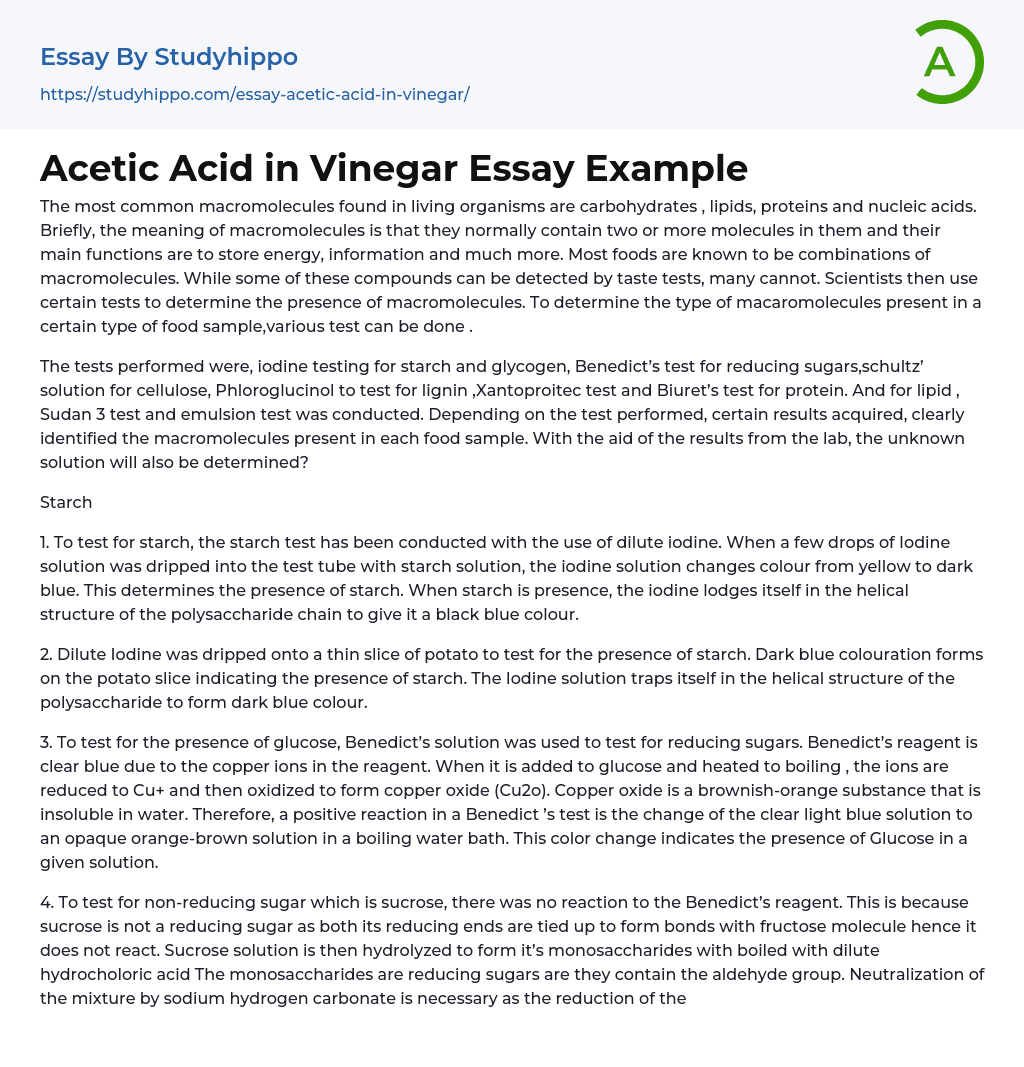Living organisms have a range of macromolecules, including carbohydrates, lipids, proteins, and nucleic acids. These macromolecules are made up of multiple molecules and have various roles such as energy storage and information transmission. While some foods contain mixtures of macromolecules that can be tasted, others cannot be identified by taste alone. As a result, scientists carry out specialized tests to determine the type of macromolecule present in a food sample.
The tests conducted included iodine testing for starch and glycogen, Benedict’s test for reducing sugars, Schultz' solution for cellulose, Phloroglucinol for lignin, Xantoproitec test and Biuret’s test for protein. Additionally, Sudan 3 test and emulsion test were performed to determine the presence of lipids. The obtained results from these tests clearly identified the macromolecules present in each food s
...ample. By utilizing the laboratory results, the unknown solution will also be identified.
Starch
The starch test involves mixing iodine solution with starch solution in a test tube. If the color of the iodine solution changes from yellow to dark blue, it indicates the presence of starch. This change in color happens because iodine binds to the helical structure of the polysaccharide chain present in starch, resulting in a black blue hue.
2. The presence of starch in a thin slice of potato is indicated by the dark blue color formed when diluted iodine is dripped onto it. This color is formed because the helical structure of the polysaccharide traps the iodine solution.
3. Benedict's solution is used to test for the presence of glucose, a reducing sugar. The solution contains copper ions that give i
a clear blue color. When heated and added to glucose, the copper ions are reduced to Cu+ and then oxidized to form copper oxide (Cu2o). Copper oxide is a brownish-orange substance that does not dissolve in water. Therefore, a positive reaction in the Benedict's test occurs when the clear light blue solution turns into an opaque orange-brown solution while boiling in a water bath. This color change indicates the presence of glucose in the tested solution.
Sucrose, a non-reducing sugar, does not react with Benedict's reagent because its reducing ends are bound to fructose, which prevents a reaction. To convert sucrose into monosaccharides, the solution is boiled with dilute hydrochloric acid. The resulting monosaccharides are considered reducing sugars due to their aldehyde group. To facilitate the reduction of copper(II) ions, the mixture is neutralized with sodium hydrogen carbonate since this reaction does not occur under acidic conditions or in the presence of excess acid.
The components of Benedict's Solution include copper(II) sulphate, sodium carbonate, and sodium citrate. The presence of aldehyde groups in reducing sugars causes the blue copper(II) ions to be converted into red copper(I) ions. This process is responsible for the observed color changes. The resulting red copper(I) oxide is not soluble in water and therefore forms a precipitate. The intensity of the final color, which is closer to brick-red, and the amount of precipitate increase with higher concentrations of reducing sugar.
Schultz's solution is applicable for conducting the cellulose test.
Cotton is composed of cellulose, which is a polysaccharide made up of beta-glucose in a linear chain. Schultz' solution is utilized because it can stain cellulose. The yellow
Schultz' solution changes from yellow to purple to indicate the presence of cellulose.
Lignin is present in the lignified cell walls of sclerenchyma and xylem. To test for the presence of lignin, acidified phlocoglucinol is used, which stains the lignin and turns it a blood red color. The toothpick is composed of sclerechyma cells with fully lignified walls, so when it is dipped into the phlocoglucinol, it becomes a blood-red color.
The presence of protein in a food sample can be tested using Million's test. This test utilizes Million's reagent, which reacts with the monomer of protein, trycosine (which contains a phenol group). When Million's reagent is added to egg albumen and gently heated, a white precipitate is formed. This precipitate coagulates upon heating and changes to a red color.
The Biuret test is used to detect protein presence. Biuret Reagent includes copper ions. Peptide bonds found in proteins and polypeptides react with alkaline copper 2 sulfate solution, forming a violet complex.
9. The Sudan 3 test is conducted to test for lipida. When Sudan 3 is added to the test tube, a red stained oil layer separates on the surface of the water. Sudan 3 stains the fat globules, causing them to separate out because they are less dense than water.
The ethanol-emulsion test is utilized to detect the existence of lipids. When oil and ethanol are vigorously shaken in a test tube, a cloudy white suspension is created. Lipids do not mix with water, so small lipid droplets form in the water, resulting in a cloudy white suspension.
- Microbiology essays
- Bacteria essays
- Cell essays
- Enzyme essays
- Photosynthesis essays
- Plant essays
- Natural Selection essays
- Protein essays
- Viruses essays
- Cell Membrane essays
- Human essays
- Stem Cell essays
- Breeding essays
- Biotechnology essays
- Cystic Fibrosis essays
- Tree essays
- Seed essays
- Coronavirus essays
- Zika Virus essays
- Organic Chemistry essays
- Acid essays
- Calcium essays
- Chemical Bond essays
- Chemical Reaction essays
- Chromatography essays
- Ethanol essays
- Hydrogen essays
- Periodic Table essays
- Titration essays
- Chemical reactions essays
- Osmosis essays
- Carbohydrate essays
- Carbon essays
- Ph essays
- Diffusion essays
- Copper essays
- Salt essays
- Concentration essays
- Sodium essays
- Distillation essays
- Amylase essays
- Magnesium essays
- Acid Rain essays
- Agriculture essays
- Albert einstein essays
- Animals essays
- Archaeology essays
- Bear essays
- Biology essays
- Birds essays




